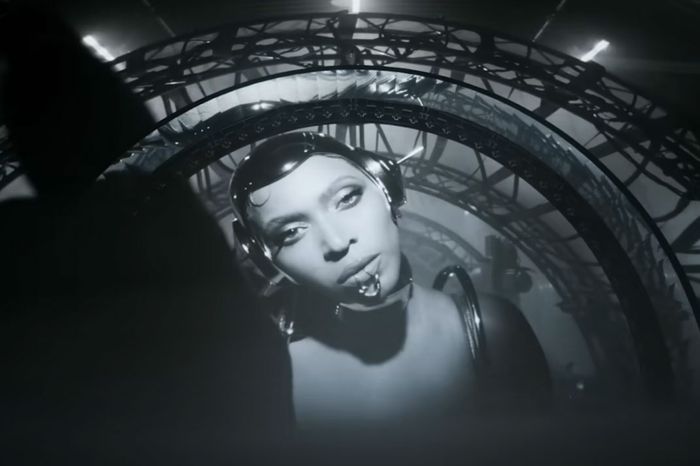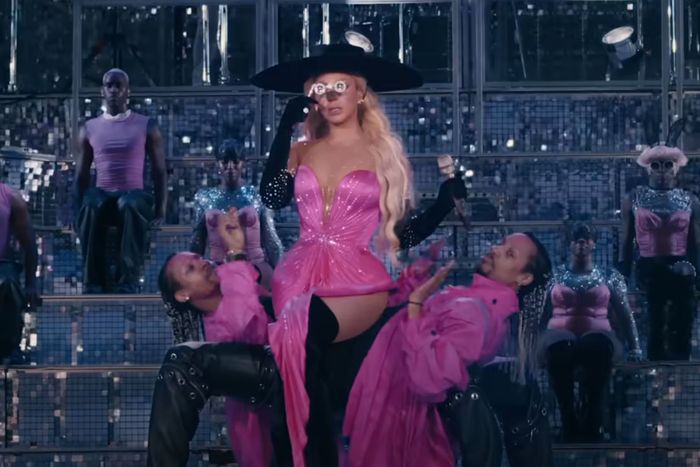
Like the album and tour with which it shares a name, Renaissance: A Film by Beyoncé seeks to be a celebration of Black queer joy. From the start, Beyoncé preaches her desire to create a “safe space.” “Renaissance means a new beginning,” she says; it’s a balm “after all we’ve been through in the world.” But what exactly is she referring to? The onslaught of death and illness brought on by the continuing pandemic? The laws aimed at criminalizing trans children and adults? The rising misogyny, homophobia, and anti-Blackness that leads to grave violence? The various, ongoing genocides? Beyoncé gives us no context for what she’s referring to or how it touches the shores of a life dominated and driven by the kind of wealth that insulates her from harm. Her words reflect broadly liberal pablum meant to give the appearance of care and mean just enough that her fans can project radicalness upon her but not so much that she would ruffle anyone enough for her to lose money or be forced to stand for something.
Beyoncé has been a remote star for years, someone far more content with having her dedicated Hive project upon her than speaking for herself. This makes the behind-the-scenes moments of her latest concert documentary, which are so primed toward engendering intimacy, rather curious. Every time you think you’ve seen behind the curtain, you realize there’s another curtain upon another stage. This isn’t new for her. Consider previous projects like the labored 2013 film Life Is But a Dream and the more successfully realized Homecoming in 2019. From this vantage point, fake intimacy is a currency she utilizes to give the appearance of revelation even if she actually remains as closed as a fist. Beyoncé positions herself not as a goddess bestowing a peek of humanity to her loyal subjects but as a relatable figure we can and should connect with. But if you have cameras on you all the time, even when you’re supposed to be “off,” when do you take down the performative mask? It isn’t even when she has knee surgery, a moment carefully documented on camera. For Beyoncé, a woman known to film her every move and house it in a temperature-controlled archive, everything is performance and each performance is merely a means of brand extension.
Opening with renditions of “Dangerously in Love” and “Flaws and All,” Renaissance: A Film centers the aesthetic might of Beyoncé’s vision. It feels particularly powerful in the ways costuming and editing meet. Beyoncé’s fashion is a fantasia of ecstatic color: a lime-green gown with a delicate hood and fabric bunched as if meant to resemble smoke unfurling; a glittering royal-blue bodysuit with thigh-high boots and garters; a bodysuit, gloves, a cowboy hat, and boots encrusted with jewels, their pattern evoking fire the colors of ice and ocean depths; a headpiece and cinched-waist number that resembles a couture queen bee. When the film flutters through various looks while keeping Beyoncé framed in the same position, it has the effect of thumbing through a keen artist’s scrapbook, shoring up the notion that no performer quite matches her sense of detail.
The transitions between songs — in the tour’s set list and in how gracefully the film is edited — are also a highlight. Her voice astounds whether hewing toward a gentle revelry on “Flaws and All,” sensuous allure in “Savage (Remix)” or growling swagger in “Formation.” Beyoncé focuses on her singing more than her dancing, which, compared to previous tours, feels subdued. She attributes this to her belief that stripping down a work to its essentials can be more powerful than the maximalist impulse. But this tour is anything but simple. There were around 160 trucks used merely to transfer the stage from stadium to stadium, and the crowd sometimes numbered up to 70,000. These are not intimate shows but a demonstration of excessive spectacle. Instead, the lower-energy, minimal movement feels like a byproduct of her knee surgery, the limits of her physicality in her 40s, and her having planned this tour soon after the physically daunting, beloved Coachella performances outlined in Homecoming.
With the time that could have been spent on limning the dynamics of her dancing, Beyoncé instead carves out space to highlight the artistry of her dedicated crew: stage hands and builders decked in shining chrome, backup singers and crucial musicians that share the live stage, seamstresses and designers, makeup artists and hair stylists, and dance captains like Amari Marshall, whose thickness and beautiful physicality casts a light all her own. But the film is still closer to an archival monument for the greatness of its performer, writer, and director. “Being a Black woman … it’s always a fight. Eventually they realize this bitch will not give up,” Beyoncé says with a mirthful quality as the documentary touches on the disagreements and minor conflicts she’s had along the way while bringing Renaissance to life after having “no days off” for over a month. Crucially, the nature of these disagreements — who within her team actually disagrees with her and any concrete tensions Beyoncé faces professionally because of being a Black woman — are never illuminated. We have to take her word for it.
Motherhood is another angle that Renaissance returns to again and again. We see Crystal, a trumpet player in the band, whose growing pregnancy is a source of pride in the documentary as well as a way to legitimize Beyoncé’s statement that this tour is really a family affair. It presents Beyoncé as a loving, all-powerful matriarch who cultivates a safe space for not only her audience but those who work for her. Yet it is how Beyoncé sees herself as a mother to her actual children that most interests me. In her ploys toward relatability, her greatest advantage is how she utilizes her blood kin. Her eldest child, Blue Ivy, is a crucial fixture as the documentary tracks her evolution within the tour. When Blue Ivy originally asks to dance onstage, her mother says “no” before agreeing to let her perform only once. In her first appearance, Blue is a little stiff and daunted, and after coming across criticisms online, she trains with even further determination and focus, as Beyoncé looks on with pride. But the warmth of her gaze is freighted by the ways she positions herself as relatable even though her wealth and power makes her anything but. Later, Beyoncé remarks that she is just like any other working mother who “brings her children to school and takes them shopping for their first day.” The next scene shows her calmly tucking her children in to sleep on a private jet.
The posturing of the tour as ultimately a close-knit family affair continues with how the presence of a beloved Knowles family member, the deceased Uncle Johnny, is felt in Renaissance. He was instrumental in not only raising the Knowles children but in crafting the early costumes of Destiny’s Child. His presence in her life and tour as a Black gay man from the South is an extension of the album’s utilization of house music and the tour’s avowed celebration of queer joy with the presence of her backup dancers the Dolls and ballroom commentator Kevin JZ Prodigy. There’s a clip in the documentary of Beyoncé name-checking Uncle Johnny while speaking at the 2016 CFDA Fashion Awards, which is meant to outline that his presence has always mattered to her career. Though Johnny died of AIDS complications, you won’t learn that from Renaissance. The only mention of his final days comes when Beyoncé’s cousin, Angie Beyince, off-handedly refers to his hospice care. At first blush, the refusal to mention AIDS is odd in a documentary, album, and tour so primed on queer Black joy. But this is by design. For there is no star of such magnitude who more cunningly positions themselves as apolitical than Beyoncé. Her performance as an icon is meant to connect with the broadest number of people possible. To do that, her refusal to stand for anything specific beyond the watered-down treatises on Black excellence must be maintained.
With “Formation” from 2016’s Lemonade, Beyoncé alchemized the aesthetics of Black radicalism. In the video, she is splayed out on a cop car in New Orleans that descends into murky waters. In her Super Bowl performance from that year, she and her dancers were decked in an all-black ensemble with raised fists meant to evoke the style of the Black Panthers without the group’s moral clarity and political conviction. When Beyoncé uses their aesthetic along with the words of Malcolm X, it behooves audiences and critics alike to hold her to a greater standard. Her apoliticism should not slide by. It should be noted that Renaissance is playing in Israel, which has led to “Break My Soul” becoming an anthem of sorts for Israelis waving their flag in screenings. Beyoncé has yet to make a statement about Palestine. But this silence is itself a statement. Perhaps she isn’t apolitical so much as an emblem of Black capitalism and wealth that seeks to maintain its stature. Renaissance: A Film demonstrates that Black joy isn’t inherently radical. In fact, without a sense of materiality, Black joy becomes directionless and easy to co-opt by the varied forces of power that are fueled by anti-Blackness. Beyoncé is an icon who has carefully maintained a sense of accessibility to anyone, anywhere, for any reason. Black musical traditions may have the potential for radicalism, but Beyoncé’s neutrality demonstrates they aren’t inherently that way. More than anything, Renaissance is a testament that Beyoncé is a brand that stands for absolutely nothing beyond its own greatness.
Correction: An earlier version of this article misstated what album “Formation” was on.



